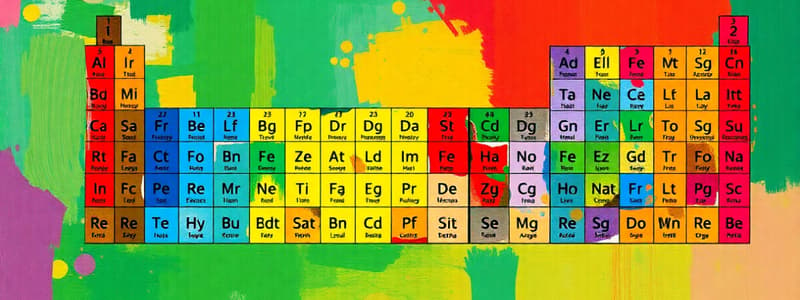Podcast
Questions and Answers
What is the primary organization method used in the periodic table?
What is the primary organization method used in the periodic table?
- Elements are arranged by their state of matter.
- Elements are organized by increasing atomic number. (correct)
- Elements are organized by their natural abundance.
- Elements are grouped based on their boiling points.
Which of the following properties is NOT characteristic of metals?
Which of the following properties is NOT characteristic of metals?
- Good conductor of electricity
- Malleable
- Ductile
- Dull appearance (correct)
How many elements are considered metalloids?
How many elements are considered metalloids?
- 5
- 7 (correct)
- 9
- 3
What characteristic do metalloids share with both metals and non-metals?
What characteristic do metalloids share with both metals and non-metals?
In which part of the periodic table are non-metals primarily located?
In which part of the periodic table are non-metals primarily located?
Who introduced the first clear version of the periodic table?
Who introduced the first clear version of the periodic table?
What are the rows of the periodic table called?
What are the rows of the periodic table called?
Which property is usually associated with non-metals?
Which property is usually associated with non-metals?
Flashcards
Metals
Metals
Elements located on the left-hand side of the periodic table, characterized by properties like luster, malleability, ductility, and good conductivity of heat and electricity
Nonmetals
Nonmetals
Elements located on the right-hand side of the periodic table, characterized by properties like dullness, brittleness, poor conductivity of heat and electricity
Metalloids
Metalloids
Elements that exhibit properties of both metals and nonmetals, located along the zigzag line on the periodic table
Groups or Families
Groups or Families
Signup and view all the flashcards
Periods
Periods
Signup and view all the flashcards
Periodic Table
Periodic Table
Signup and view all the flashcards
Physical Property
Physical Property
Signup and view all the flashcards
Chemical Property
Chemical Property
Signup and view all the flashcards
Study Notes
Periodic Table Organization
- Scientists believe there are 118 elements, with 90 occurring naturally.
- The periodic table organizes elements by properties, making them easier to study.
- Early versions, like Newland's (1864), ordered elements by increasing mass.
- Mendeleev (1869) organized the table using mass and properties, leaving gaps anticipating undiscovered elements.
- Columns are called families or groups, and elements within each group share similar properties.
- Rows are called periods and are organized by increasing atomic number.
- The periodic table categorizes elements into metals, nonmetals, and metalloids based on various properties.
Metals
- Most elements are metals, typically located on the left side of the table.
- Metals generally have a lustrous (shiny) appearance, are hard, and malleable (can be shaped).
- Metals are also ductile (can be drawn into wires) and good conductors of heat and electricity.
Nonmetals
- Nonmetals are located on the right side of the table.
- Nonmetals tend to be dull, brittle, and poor conductors of heat and electricity.
Metalloids
- Metalloids are located along the zigzag line on the periodic table.
- Metalloids have properties of both metals and nonmetals, often acting as semiconductors.
- Metalloids are typically shiny, brittle, and can conduct electricity, but not as well as metals.
Studying That Suits You
Use AI to generate personalized quizzes and flashcards to suit your learning preferences.




